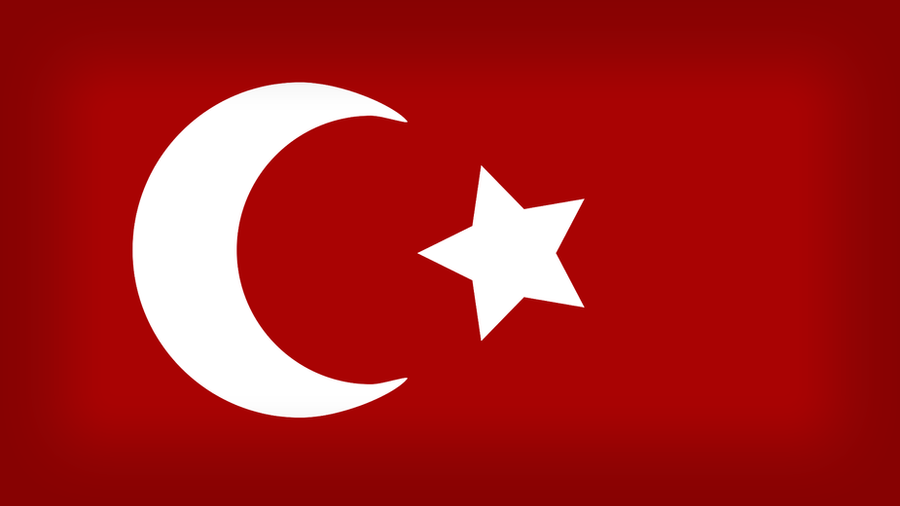
The Flag of the Ottoman Empire, bearing its distinct crescent and star.
This week, the Chicago Cubs won the World Series in a dramatic 8-7 victory against the Cleveland Indians. What makes this game historic is that the last time the Cubs won was over 100 years ago in 1908. This was only six years before the start of WWI, a globe-spanning conflict that earned its earlier title of “The Great War”. Involved in this war, among many nations, was a dying superpower that I will be covering today: the Ottoman Empire (yes, I just connected baseball to an empire). Founded circa 1300 A.D., this sprawling Islamic Caliphate expanded from a small Turkish tribe to conquer significant portions of North Africa, Europe, and the Middle East and create one of the greatest empires in the history of the world. It united and stabilized the Near East (something I wish could happen today) under an efficient bureaucracy, remarkably fair judicial system, and terrifyingly effective army that fell tragically, like Rome, due to internal corruption, rebellion, and wars with foreign nations.

A map of the Ottoman Empire detailing its expansion throughout its lifespan.
The origins of the Ottoman Empire are in a small region in present-day Turkey. In the late 13th Century, the Seljuk Empire, a former superpower in the region, was fractured due to Mongol invasions (can’t stop the Mongols!) and internal conflict. One of the many principalities that the empire had fractured into was the Ottoman Principality, located on the other side of the Bosphorus straits from Greece and Constantinople. In 1299, Osman I, the ruler of the princedom, started a military campaign against the neighboring Byzantine (basically the Eastern Roman Empire with a touch of Greek culture) cities, conquering a relatively small swath of land by 1300. Although this initial push was modest, in the next 200 years the Ottomans were able to conquer much of Anatolia (a fancy name for modern day Turkey), Greece, and the all but impregnable city of Constantinople through a combination of brilliant tactics, impressive military technologies, and lots of money.

Artistic rendering of the siege of Constantinople. Note that the Ottomans are using cannons to break the previously impenetrable walls.
By 1520, the Ottomans had seized control of a huge area of land stretching from Egypt in the south to the border of Hungary in the north. At this time, the greatest Ottoman ruler came to power: Suleiman the Magnificent. Suleiman conquered more territory, reaching into Europe, and taking large portions of North Africa and Mesopotamia. He also established many treaties with European powers and encouraged European traders to use the Silk Road, further enriching his already wealthy country. The Sultan also commissioned great architectural works such as the Suleymaniye Mosque, codified Ottoman law into a remarkably unbiased and fair judicial system, and was reputed to be a just and humane ruler.

The Suleymaniye Mosque, located in Istanbul, the former capital city of the Ottoman Empire.
After Suleiman’s reign ended, the Empire took a turn downhill and was never able to recover its glory. In the 17th Century, the Empire was exhausted by numerous wars in the East and with Europe. Treaties with Austria ceded Ottoman land, other nations caught up to the empire’s formerly superior technology, and corruption was rampant within the vast bureaucracy. Rulers in the 18th century attempted to reform these broken institutions, and they did, executing corrupt officials and taking care of inflation, but they did not address the root of the problem: a nobility obsessed solely with keeping power and personal enrichment. In the 19th Century, a system of reforms known as the Tanzimat Reforms was enacted, modernizing and reorganizing the bureaucracy, encouraging manufacturing, entering less foreign wars, and making agreements with various European nations, creating internal strife between reformers and traditionalists.

The Middle East after the fall of the Ottoman Empire.
Finally, in WWI, the Ottoman Empire joined the losing side of the war with Germany and Austria-Hungary and the consequence of this was its final fall. Its territories were divided among the winning European powers or given over to self-governance, and the empire that had struck fear into the hearts of Europe was destroyed by its ancient enemy. This dissolution created many artificial nations with disparate peoples that exist in the Middle East today, resulting in almost never-ending conflict between different groups and enabling dictators to rise to power. Maybe if the empire never fell, many of the problems of today would not exist. We should learn from history and see how deposing dictators and dismantling nations without having plans to fill the vacuum will always end badly.
Sources:
http://www.newworldencyclopedia.org/entry/Seljuk_Turks
http://www.newworldencyclopedia.org/entry/Ottoman_Empire#The_Tanzimat_Reforms
http://www.bbc.co.uk/religion/religions/islam/history/ottomanempire_1.shtml
http://www.allaboutturkey.com/ottoman.htm
https://www.britannica.com/place/Ottoman-Empire/The-decline-of-the-Ottoman-Empire-1566-1807